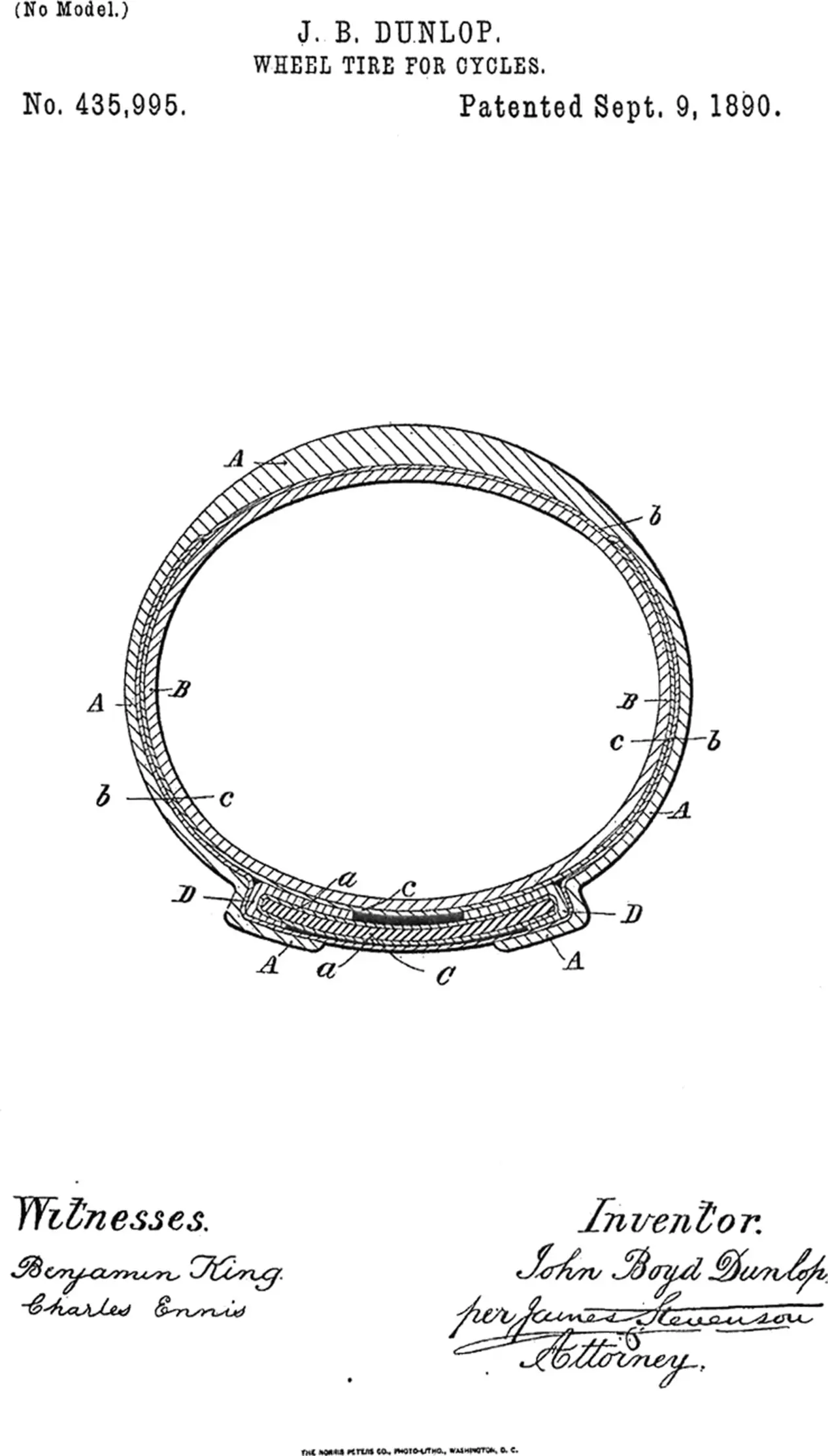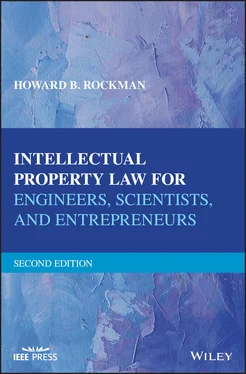He took this wheel and a metal wheel from his son’s tricycle, and rolled both of them across the yard together. The metal wheel stopped rolling, but the pneumatic wheel continued until it hit a gatepost and rebounded off the post. Dunlop then placed pneumatic tires on both rear wheels of his son's tricycle, and the tricycle's rolling improved. He then constructed larger tires for bicycles with even more startling results.
He began testing his pneumatic tires at a sports ground in Belfast, and obtained a patent on his pneumatic tires on December 7, 1888. However, completely unknown to Dunlop, another Scotsman, Robert William Thompson from Stonehaven, had patented a pneumatic tire in 1847. Thompson had earlier placed his tires on horse‐drawn carriages in London, but they never caught on, because at the time they were too expensive to manufacture. Frustrated with this result, Thompson turned to solid rubber tires for his future inventions. Hence, it might be said that John Dunlop “reinvented” the pneumatic tire.
In 1889, William Hume won a bicycle race in Ireland using Dunlop tires for the first time, and he subsequently won more races in England. Hume was the first member of the public to purchase a bicycle fitted with pneumatic tires, after Dunlop suggested that Hume use them in a race. On May 18, 1889, Hume won all four cycling events at the Queen’s College Sports Event in Belfast. A short time later, in Liverpool, he won all but one of the cycling events, lifting inflatable tires into the spotlight, and making them the standard for bicycles. Losers in the Liverpool event included the sons of the head of the Irish Cyclist Association, Harvey Du Cros. Du Cros saw an opportunity, and proceeded to build a personal relationship with Dunlop. Together, they formed a company, which acquired the rights to Dunlop’s patent.
Two years after Dunlop was awarded his patent, he was officially informed in 1891 that his patent was invalid, based on Thompson’s earlier patent, which issued in France in 1846 and in the United States in 1847. However, Dunlop and Du Cros continued to capitalize on pneumatic tires for bicycles, and they acquired a Dublin company and renamed it Pneumatic Tyre and Booth's Cycle Agency. Dunlop retired in 1895, and Du Cros sold the entire bicycle tire business in 1896 to a British financier, Terah Hooley, for £3 million. Hooley then made improvements, and resold the company to the public for £5 million. Du Cros remained head of the business until he died. Early in the twentieth century, the company was renamed Dunlop Rubber.
The production of automobile tires did not begin until 1900, well after Dunlop’s retirement. As a result, Dunlop did not acquire any considerable remuneration from his invention.
Inflatable tires provide a smoother ride and increased traction since the wheel deforms slightly when it meets the road, creating a friction bond between the vehicle and the road as the tire deforms and casts a wider and longer footprint. This is in contrast with solid rubber tires, which do not deform. For reasons that do not appear as clear as they should, solid rubber tires remain the material of choice for tricycle wheels, while today inflatable tires are the choice for bicycles and most other vehicles worldwide. At the time Dunlop came up with his invention, bicycles were becoming extremely popular, and the lighter, air‐filled tire resulted in a better ride with less vibration.
For 50 years after Dunlop’s invention, vehicle tires were made using an inner tube containing compressed air and an outer casing. The casing protected the inner tube and provided the tire with traction. The tire casing was reinforced with layers comprising rubberized fabric cords embedded in the rubber, and these were known as “bias ply tires,” since the cords in the single ply ran diagonally from the bead of one inner rim to the bead on another rim. The orientation of the cords is reversed from ply to ply, so the cords crisscross each other. Today, you can still find bias ply tires as equipment for antique and collector cars, and for various types of off‐road tractor tires. In 1948, steel‐belted radial tires appeared in Europe, and are so named because the ply cords radiate at a 90° angle from the wheel rim, such that the casing is strengthened by a belt of steel fabric extending around the circumference of the tire. Radial tire ply cords are composed of nylon, rayon, or polyester. The advantages of radial tires include longer tread life, improved steering, and less rolling resistance, which results in increased gas mileage. On the negative side, radial tires have a harder riding quality, and are also about twice as expensive to make as previous pneumatic tires.

3
Introduction to Patents
3.1 BRIEF HISTORY OF PATENT PROTECTION
3.1.1 Early European Patent Custom
It is commonly recognized that the history of patents is wrapped in obscurity and uncertainty. Prior to any patent system, there was a “patent custom” in many countries throughout Europe. Before the creation of the U.S. Constitution, the governments of several European countries granted exclusive rights in patentable and sometimes unpatentable subject matter as a “privilege” of the crown, rather than a property right available to all inventors. At the time the United States transitioned to a federal form of government under its Constitution, the patenting of inventions had been known and practiced in several countries for centuries. The “patent custom” that was known to the framers of the U.S. Constitution, simply put, was the practice of the state granting some form of limited‐term exclusive right to engage in a new trade or craft, sometimes denominated an industry, to the person or persons responsible for introducing that industry into the state, either by creation or importation. The privilege consisted of a temporary and exclusive right to commercialize the new subject matter, covered by the grant, whether it be called a patent, letters patent, or something else.
The early patent custom involved grants of privileges rather than property rights. The distinction between a patent privilege and a patent property right is an important one and not always recognized in the early literature of the patent law. Nonetheless, inventors, who had the most practical interest in obtaining exclusive rights to commercialize their inventions, were increasingly aware of the distinction, and, by the eighteenth century, they began to argue that they had a natural, inherent property right in their inventions, which it was the obligation of the state to protect, thus arguing that the state had no right to refuse granting them an exclusive position in their inventions for a limited time.
In an effort to encourage individuals who contributed to the advance of a culture, earlier governments recognized the “natural” right of a person to his or her own ideas and inventions, and strengthened that right by granting governmental proclamations and regulations restraining others from exercising the opposing “natural” right to copy. For the most part, this protection was limited in terms of time by those early governments. Since these early forms of government were of an authoritarian nature, ruled by monarchs, sovereigns, kings, and emperors, the practice that was most prevalent then was to grant royal favors to certain individuals, giving exclusive rights to sell certain commodities which had previously been available to be sold by anyone. Needless to say, this type of monopoly did not find favor with the general public. These so‐called city or state monopolies were outlawed in the Roman Empire in a proclamation by Emperor Zeno in 480 AD. His proclamation read:
Читать дальше













